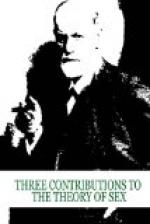[3] For the difficulties entailed in the attempt to ascertain the proportional number of inverts compare the work of M. Hirschfeld in the Jahrbuch fuer sexuelle Zwischenstufen, 1904. Cf. also Brill, The Conception of Homosexuality, Journal of the A.M.A., August 2, 1913.
[4] Such a striving against the compulsion to inversion favors cures by suggestion of psychoanalysis.
[5] Many have justly emphasized the fact that the autobiographic statements of inverts, as to the time of the appearance of their tendency to inversion, are untrustworthy as they may have repressed from memory any evidences of heterosexual feelings.
Psychoanalysis has confirmed this suspicion in all cases of inversion accessible, and has decidedly changed their anamnesis by filling up the infantile amnesias.
[6] With what reserve the diagnosis of degeneration should be made and what slight practical significance can be attributed to it can be gathered from the discussions of Moebius (Ueber Entartung; Grenzfragen des Nerven- und Seelenlebens, No. III, 1900). He says: “If we review the wide sphere of degeneration upon which we have here turned some light we can conclude without further ado that it is really of little value to diagnose degeneration.”
[7] We must agree with the spokesman of “Uranism” that some of the most prominent men known have been inverts and perhaps absolute inverts.
[8] In the conception of inversion the pathological features have been Separated from the anthropological. For this credit is due to I. Bloch (Beitraege zur Aetiologie der Psychopathia Sexualis, 2 Teile, 1902-3), who has also brought into prominence the existence of inversion in the old civilized nations.
[9] Compare the last detailed discussion of somatic hermaphroditism (Taruffi, Hermaphroditismus und Zeugungsunfaehigkeit, German edit. by R. Teuscher, 1903), and the works of Neugebauer in many volumes of the Jahrbuch fuer sexuelle Zwischenstufen.
[10] J. Halban, “Die Entstehung der Geschlechtscharaktere,” Arch. fuer Gynaekologie, Bd. 70, 1903. See also there the literature on the subject.
[11] According to a report in Vol. 6 of the Jahrbuch f. sexuelle Zwischenstufen, E. Gley is supposed to have been the first to mention bisexuality as an explanation of inversion. He published a paper (Les Aberrations de l’instinct Sexuel) in the Revue Philosophique as early as January, 1884. It is moreover noteworthy that the majority of authors who trace the inversion to bisexuality assume this factor not only for the inverts but also for those who have developed normally, and justly interpret the inversion as a result of a disturbance in development. Among these authors are Chevalier (Inversion Sexuelle, 1893), and v. Krafft-Ebing ("Zur Erklaerung der kontraeren Sexualempfindung,” Jahrbuecher f. Psychiatrie u. Nervenheilkunde, XIII), who states that there are a number of observations “from which at least the virtual and continued




